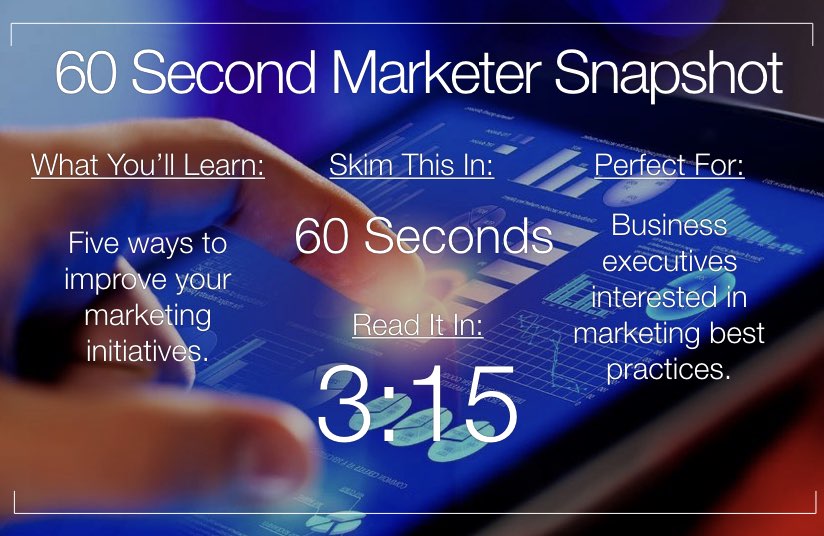Author: Jessica Hawthorne-Castro, CEO
Original Publication: 60 Second Marketer
Date Published: August 10, 2017
 Marketing teams have always been expected to prove their mettle, but the acceleration of mixed-media campaigns and budget increases for marketing technology are raising the stakes. And while these campaigns and technologies increasingly rely on digitization that can aid in tracking results, marketers still face challenges.
Marketing teams have always been expected to prove their mettle, but the acceleration of mixed-media campaigns and budget increases for marketing technology are raising the stakes. And while these campaigns and technologies increasingly rely on digitization that can aid in tracking results, marketers still face challenges.
To hone accountability, marketers will need to do their research, capitalize on automation platforms that incorporate direct response (DR) marketing, and continue to study how people use their myriad mobile devices to engage with companies.
According to the most recent Cisco Visual Networking Index (VNI) Global Mobile Data Traffic Forecast, there were almost half a billion mobile devices and connections added in 2016 around the world. Smartphones accounted for most of that growth, and all those phones are fueling mobile ad spend. Research firm BIA/Kelsey estimates that annual U.S. mobile ad spending will grow from $33 billion in 2016 to $72 billion by 2021.
Also growing are marketing budgets. According to Gartner’s 2016-2017 CMO Spend Survey, marketing budgets increased to 12 percent of company revenue in 2016 and CMO marketing technology spend is on track to exceed CIO tech spend in 2017. That influx of money will no doubt add new stressors on accountability.
Fortunately, there are tools and processes marketing teams can incorporate into their operations that will help determine and demonstrate accountability.
Use Marketing Automation
Platforms that leverage automation are designed to market across multiple online channels, automate repetitive tasks and measure and track results. This gives organizations the tools they need to measure mixed-media modeling, which involves analyzing sales data to determine the effectiveness of the marketing mix.
We’ve noticed an uptick in the use of marketing automation in our own work at Hawthorne. Marketers are using technology applications and platforms to figure out how much “weight” to put on which advertising channels, which platforms are performing the best (and worst) and how to effectively allocate budgets among those various options.
These insights can then help determine the optimal media mix, which can be a major challenge in today’s highly-fragmented digital media world, where consumers hop back and forth between devices and view ad content on each.
Incorporate Pixel Technology
Pixel technology can be used to figure out and track consumer engagement levels. Pixels, or small lines of code, can be added to client websites to track the consumer from beginning-to-end in order to timestamp when they first saw an advertisement and then went directly to the website (or Googled it).
The technology then tracks their path through the website on each individual page and even creates a heatmap of what they are looking at on each page. This tracks consumer engagement and whether or not they made a purchase.
Combine DR and Marketing Automation
DR is an accountable, measureable and actionable way for brands to engage and collaborate with their customers. When combined with marketing automation, advertisers have even more opportunity to measure accountability. They can use an array of online and offline media choices to quickly capture engagement and directly pitch clients at the top of the sales funnel who are happy because they know their target audience is on the radar.
For example, Hawthorne recently created a custom campaign that incorporated programmatic and addressable TV and targeted 18- to 25-year-olds, who represent around 10 percent of people in U.S. households with TVs. We then used mixed-media modeling to demonstrate the campaign’s impact across multiple platforms and to maximize the advertiser’s message across channels.
Prepare for a Learning Curve
Automating and fine-tuning a campaign with new technology always involves a learning curve. It’s important to do you research up front, particularly in terms of identifying and leveraging cross-device segmentation. Marketers have to figure out the paths that different demographics are going to take, as well as understand how quickly they will move through the sales funnel and make a purchase or sign up for a service.
Identify Top Advertising Mechanisms
More precisely, understand how people respond from one end of the sales funnel to the other, including how they engage across devices. It all boils down to understanding the lifetime value of each customer and connecting that information back into advertising, station selection, creative and any other element that has an impact on sales.
About the Author: Jessica Hawthorne-Castro is the CEO of Hawthorne an award winning technology-based advertising agency specializing in analytics and accountable brand campaigns for over 30-years. Hawthorne has a legacy of ad industry leadership by being a visionary in combining the art of right-brain creativity with the science of left-brain data analytics and neuroscience.





